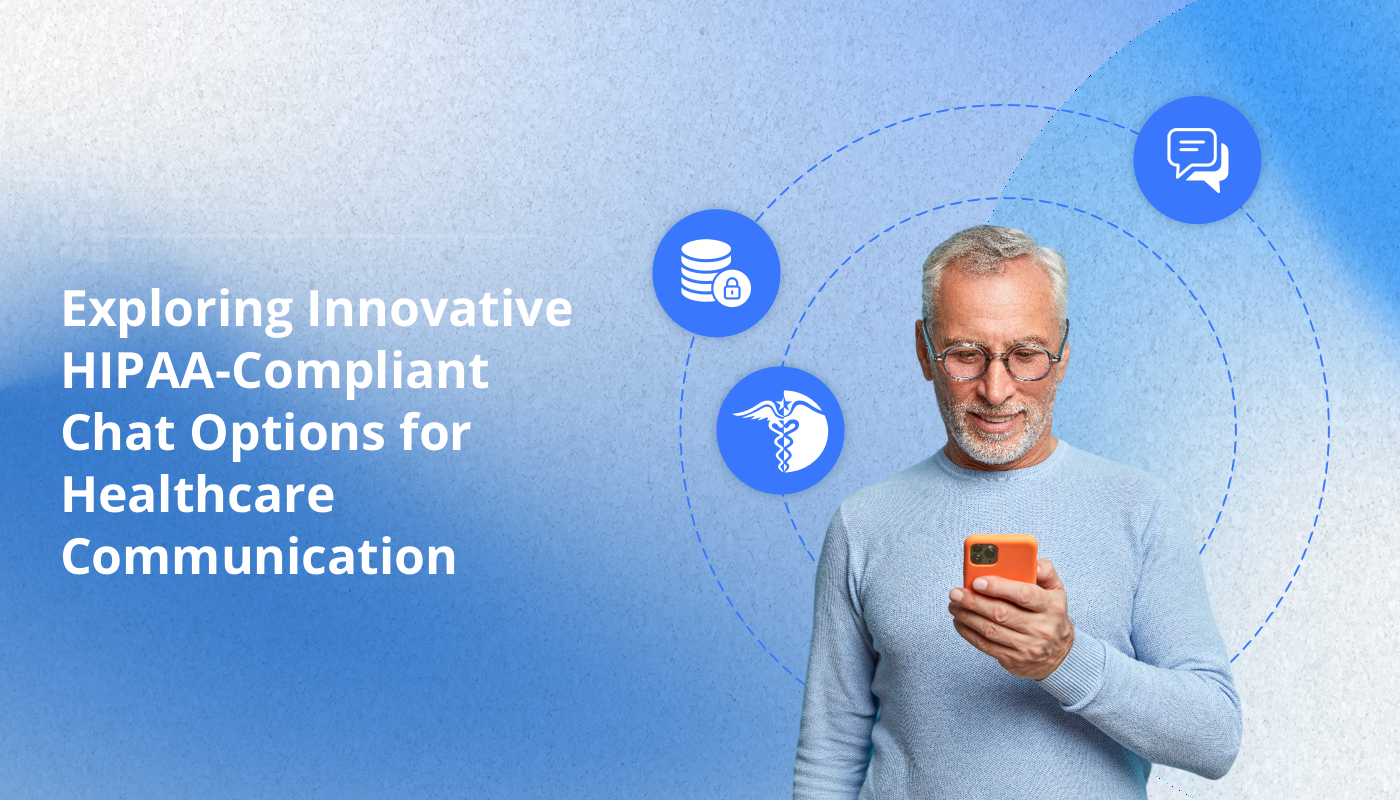
Summary: The following article explores the latest innovations in HIPAA compliant chat. It outlines several key challenges of achieving HIPAA compliance, along with suggestions for overcoming them.
Table of Contents
Introduction
Effective communication stands as the cornerstone of quality patient care and operational efficiency in modern healthcare. With the ever-accelerating pace of technological advancement, healthcare providers are continuously seeking secure and efficient methods to communicate sensitive information while adhering to strict HIPAA (Health Insurance Portability and Accountability Act) regulations.
In the following article we will uncover the latest innovations in HIPAA-compliant chat options tailored specifically for healthcare communication. In an era where traditional communication methods struggle to keep pace with the demands of a rapidly evolving healthcare industry, chat platforms emerge as promising solutions, offering real-time exchanges that foster collaboration among healthcare professionals and enhance patient engagement.
HIPAA compliance for chat platforms or any other form of digital communication is of paramount importance in healthcare due to the sensitive nature of patient information and the potential consequences of unauthorized disclosure or breach.
HIPAA was enacted in 1996 to safeguard sensitive patient information and ensure its confidentiality. HIPAA comprises various regulations, including the Privacy Rule, Security Rule, and Enforcement Rule, which collectively establish standards for protecting patients’ medical records and other health information.
Compliance with HIPAA regulations helps protect patient privacy, maintain trust in healthcare providers, and mitigate legal and financial risks associated with non-compliance.
Learn more about, Top HIPAA Compliant Chat Apps
Latest Innovations in HIPAA Compliant Chat Solutions
HIPAA compliant chat solutions are constantly evolving to meet the needs of modern healthcare communication. Here are some areas where we’re seeing innovation:
Integration with existing workflows
Compliant chat is being seamlessly integrated with existing electronic health record (EHR) systems and patient engagement platforms. This allows healthcare providers to seamlessly communicate and share information while maintaining a centralized patient record.
Improved usability and accessibility
New chat solutions are focusing on being user-friendly for both patients with varying technical abilities and healthcare providers with busy schedules.
- Mobile Compatibility: Many HIPAA chat tools are optimized for mobile devices, allowing healthcare professionals and patients to access the platform conveniently from smartphones or tablets, enhancing accessibility and flexibility.
- User-friendly Interfaces: Chat solutions are focusing on intuitive and user-friendly interfaces that are easy to navigate and require minimal training for healthcare professionals and patients to use effectively. This includes clear layouts, simple navigation menus, and intuitive design elements.
- Multi-platform Support: Innovations in HIPAA chat solutions include support for multiple platforms, such as web browsers, desktop applications, and mobile apps. This ensures that users can access the platform from their preferred devices and operating systems.
- Voice Chat Options: For patients who may have difficulty typing or reading, voice chat offers an alternative way to engage with healthcare providers. This can help bridge the gap for individuals with disabilities or language barriers.
AI Chatbot Integration
Some innovative chat solutions are incorporating AI-powered chatbots to assist with triage, appointment scheduling, and basic information gathering. These chatbots can help streamline communication while ensuring that sensitive information is handled securely and in compliance with HIPAA regulations.
Enhanced Security Features
As cyber threats continue to evolve, compliant chat platforms are implementing even more robust security measures.
- Encrypted Messaging: Many HIPAA chat tools now offer end-to-end encryption for messages, ensuring that sensitive information is protected during transmission and storage. This encryption technology helps prevent unauthorized access and ensures that only the intended parties can read the messages.
- Audit Trails and Reporting: To maintain compliance and facilitate auditing, many chat solutions provide detailed audit trails and reporting features. These tools help healthcare organizations track and monitor communications, ensuring that they meet regulatory requirements.
- Secure messaging features: To ensure that communications remain confidential, additional security measures have been introduced such as message expiration, remote wipe capabilities, and two-factor authentication.
OmniChannel Communication
HIPAA chat can be integrated with other communication channels like secure text messaging, patient portals, and video conferencing. This creates a unified platform where patients can switch between channels effortlessly, depending on their needs and preferences.
The focus of innovation in HIPAA compliant chat solutions is on improving communication, security, and usability for both patients and healthcare providers. However, it’s important to note that while these innovations can enhance patient care, healthcare organizations must still implement robust policies, procedures, and training to ensure that their chat solutions are used in a HIPAA-compliant manner.
Learn more about, Top 4 Essential Telemedicine Features You Need to Know
Challenges of Achieving HIPAA Compliance in Digital Communication
Achieving innovative HIPAA-compliance in digital communication presents several challenges that must be addressed. The widespread adoption of mobile devices, messaging apps, and telehealth platforms has expanded the scope of communication channels, increasing the complexity of ensuring HIPAA compliance. Here are some of the key challenges, but also suggestion for how they can be overcome:
- Ensuring robust security and privacy:
Protecting sensitive patient health information (PHI) is paramount in any HIPAA-compliant solution. Ensuring you have the necessary security measures in place can be technically complex and resource-intensive.
Solution: Invest in a comprehensive secure solution that offers multiple layers of protection in a unified platform. Look for a solution that provides features such as encryption, access controls, intrusion detection/prevention systems, endpoint security, and regular security updates.
- Maintaining compliance with evolving regulations:
HIPAA regulations and guidelines are subject to change, and healthcare organizations must stay up-to-date with the latest requirements. Ensuring that chat solutions remain compliant as regulations evolve can be challenging, especially for smaller healthcare providers with limited resources.
Solution: Staying informed about changes to HIPAA regulations and industry standards is essential. Regular audits, updates to policies and procedures, and ongoing staff training help ensure compliance with evolving requirements.
- Integrating with existing healthcare systems:
Many healthcare organizations have legacy systems and workflows that may not seamlessly integrate with new chat solutions. Achieving seamless integration without disrupting existing processes or compromising data integrity can be a significant challenge.
Solution: Seamless integration with existing healthcare systems requires careful planning and coordination. Utilizing APIs and platforms that offer interoperability standards can facilitate data exchange and streamline workflows across different systems.
- Overcoming resistance to change:
Introducing new communication technologies often faces resistance from healthcare professionals and patients accustomed to traditional methods. Addressing concerns about privacy, ease of use, and the potential impact on workflow can be an obstacle to adoption.
Solution: Effective change management strategies, including clear communication, stakeholder engagement, and training programs, can help address resistance to adopting new digital communication technologies. Highlighting the benefits and addressing concerns can encourage acceptance and adoption among users.
- Managing and securing mobile devices:
With the increasing use of mobile devices in healthcare, ensuring that chat solutions are secure and compliant on various mobile platforms and devices can be a complex undertaking.
Solution: Implementing mobile device management (MDM) solutions with features such as encryption, remote wipe capabilities, and application whitelisting can help manage and secure mobile devices. Establishing BYOD policies and providing training on mobile security best practices are also essential.
- Managing costs and resources:
Implementing and maintaining innovative HIPAA-compliant chat solutions can be costly, especially for smaller healthcare providers with limited budgets. Balancing cost-effectiveness with functionality and compliance can be a significant challenge.
Solution:Implementing cost-effective solutions and optimizing resource allocation are key to managing costs and resources effectively. For example, leveraging a HIPAA communication solution provider can help manage costs and resources for healthcare organizations. These solutions typically involve subscription-based pricing models or pay-as-you-go plans, which can be more cost-effective than building communication features from scratch. This approach eliminates the need for upfront investment in infrastructure, development, and ongoing maintenance costs.
Overcoming these challenges requires a collaborative effort among healthcare organizations, technology providers, and regulatory bodies. Continuous innovation, education, and best practice sharing can help drive the development and adoption of HIPAA-compliant chat solutions that meet the evolving needs of healthcare communication while maintaining robust security and compliance.
Final Thoughts
As we’ve explored the latest innovations in HIPAA-compliant chat, it’s clear that these platforms offer a plethora of capabilities to meet the diverse needs of healthcare providers and patients alike in the realm of remote healthcare.
Partnering with a third-party provider of HIPAA-compliant chat solutions, such as QuickBlox, can help healthcare organizations address many of the challenges associated with implementing innovative and compliant communication channels. QuickBlox specializes in developing and maintaining HIPAA-compliant communication solutions and implements advanced security measures to protect sensitive patient health information (PHI).
Talk to a sales expert
Learn more about our products and get your questions answered.
Contact sales






